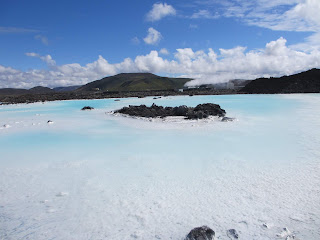NORTH WINDS: FAROE AND ORKNEY ISLANDS
“Far out in the radiant ocean glinting like quicksilver there lies a solitary
little lead-coloured land. The tiny rocky shore is to the vast ocean just about
the same as a grain of sand to the floor of a dance hall. But seen beneath a
magnifying glass, this grain is nevertheless a whole world.” -William Heineson
(Faroese writer, 1900-1991), The Lost
Musicians
 |
| Soaring cliffs of the Faroe Islands |
At each
port, our ship flies the flag of our host. So, as we arrived at Torshavn in the
Faroe Islands, I expected to see the Danish flag, given that the Faroes are a
self-governing possession of Denmark. But, instead, the flag was a red cross
with a white background. Of course, there is a story behind this.
During
WWII, Denmark was occupied by Nazi Germany, but the Faroes were not. The
British, eyeing the islands as a possible northern stronghold, instead moved in
and started to build a defense system there. But there was a problem: when
Faroean ships were at sail, the allies sometimes attacked them because they mistook
the Danish-flagged ships for those controlled by the Nazis. So, the Faroe Islands
developed its own flag in order to distinguish itself from Denmark. And, today,
as a largely autonomous region, it has retained that flag as a symbol of their
quasi-independence.
 |
| A Faroean inlet |
 |
| A village in the Faroes, full-time population 33 (but some are vacation homes) |
Soaring
cliffs, waterfalls upon waterfalls, tiny villages, and sheep everywhere
characterize the landscape of the Faroe Islands. Gray skies covered our day
there, but the beauty of the islands nevertheless shined through.
 |
| Fish farming, a major industry of these northern islands |
Gray skies
also were the umbrella of our visit to the Orkney Islands, a set of Scotland’s
northerly islands. Steeped in history dating back 5,000 years, the Orkney
Islands are a treasure trove of archaeological sites, with Neolithic villages
being uncovered seemingly every time someone turns a spade to the earth. Most
famous for its standing stones, it is believed that the pattern of standing
stones on the north island were placed deliberately, as, taken together, they
are in the same pattern as the belt of Orion constellation, and are comprised
of stones that have been found to originate from the various villages around
the area.
 |
| Standing Stones of Stennes, on the north island of Orkney |
An
interesting tale from the area’s history is that of Saint Magnus Erlendsson,
Earl of Orkney in the early 1100s. A
rival earl insisted that there could be only one ruler of the islands.
Preparing for a battle, the two earls agreed to terms of battle, but the other
earl, Haakon, betrayed the terms by appearing with quadruple the forces agreed
to. Haakon, deciding that Magnus must be killed, ordered his aides to do the
deed, but none would agree to it, until his cook was finally forced into the
act. Magnus told the cook that he forgave him, and asked that he kill him by a
blow to the head with an axe, so that he could die as a warrior, rather than by
beheading, the fate accorded to criminals. The cook agreed, and thus ended
Magnus’ life. However, wherever Magnus’ bones were buried, miracles were
reported to occur. Thus, Magnus’ remains were moved all over the islands, so
that many could share in the miracles.



I loved Orkney. Thanks for sharing your adventures
ReplyDelete